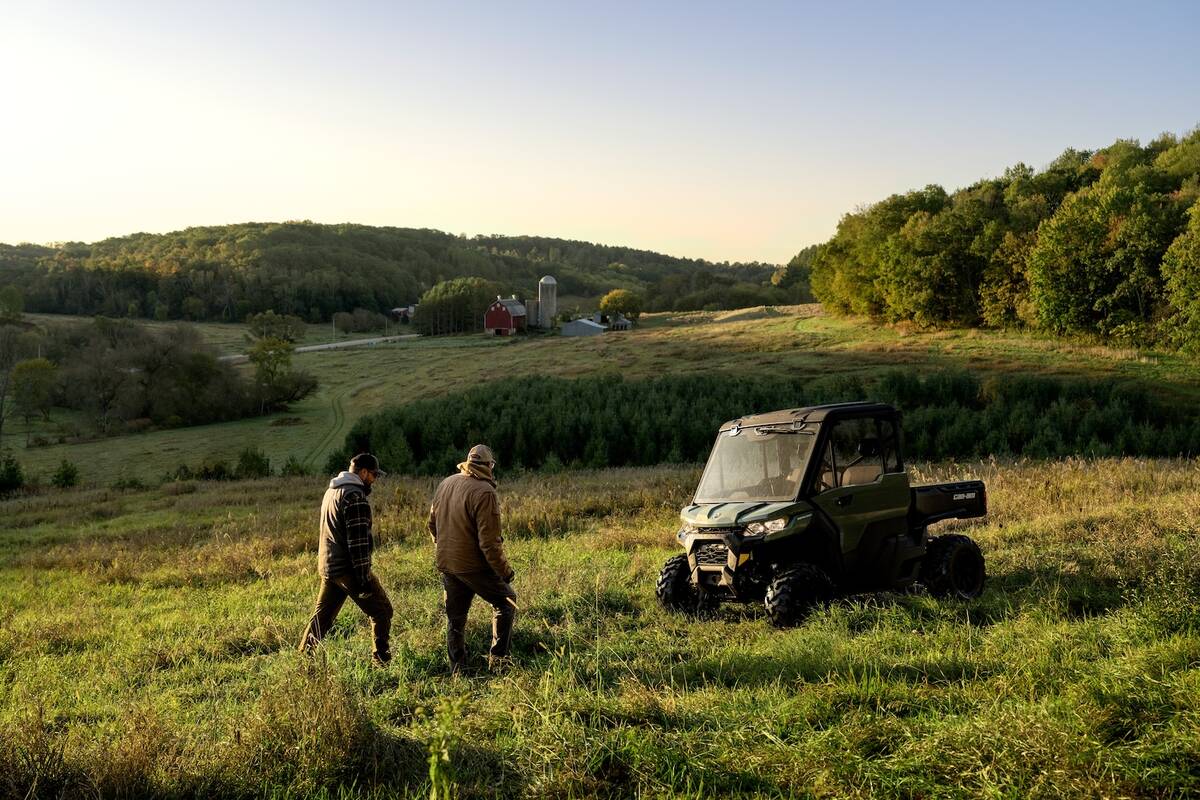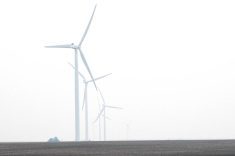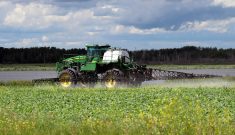In 1888 Bertha Benz drove her homemade car on a 212-km round trip to Mannheim and Pforzheim in Germany. The fuel tank was 4.5 litres, and there were no gas stations along the way. There were probably no paved roads either and the reliability of the car was unproven.
It might have been easier to take a horse and carriage. But why choose the easy way out if you can go down in history as the “world’s first cross-country car trip?”
The internal combustion engine has served us well since then and Bertha Benz’s car company continues to thrive to this day.
Read Also

New, more comfortable cab available for Can-Am Defender UTVs
Farmers and ranchers looking to keep inclement weather out of the UTV get a new cab option on Can-Am’s three- and six-seater Defender DPS HD10 side-by-side models.
By 2018, I’d been farming for about 30 years on my 500-hectare farm southeast of Winnipeg. I’d made a little money and wanted something “green.” And it was not a green tractor.
My farm is totally dependent on fossil fuels to operate, and I wanted something that would be less polluting, even if it was only a small step in that direction.
Going all-in on electric?
I looked at all-electric cars, but they come with a large lithium-ion battery that has its own environmental concerns. These cars cost around $80,000, which was eight times more than I had ever invested in any vehicle. I could not force myself to spend this much money on a vehicle that would last only 20 years. More on that later.
In the end I bought a solar system for $120,000. The lifespan hopefully will be longer than my own. Of that cost, $40,000 was covered by grants/subsidies from Manitoba Hydro, which of course come from Manitoba Hydro users. So, I would like to thank all Manitoba Hydro customers who have sent $40,000 my way.
The system works great, and some of the electricity we produce is sent to the grid and we’re paid full retail price. This means I did not need to buy those polluting batteries. It also means I get another subsidy from Hydro.
I have added 40 kW of infrastructure to the world, but Hydro cannot reduce its infrastructure by an equal amount because some people demand electricity at night. In Manitoba, where most electricity comes from hydroelectric generators, I have replaced renewable hydro energy with renewable solar energy.
I question the greenness of my project. Maybe solar cells are more appropriate in areas where electricity comes from coal or natural gas?
Organic?
My 500-ha grain farm is a bit hypocritical, as I struggle with excessive chemical usage on my zero- and minimum-tillage land. I converted about a fourth of the land to certified organic.
This solved the problem of chemical usage but increased my diesel usage as I sometimes need to mouldboard-plow the organic hemp fields. This uses 2,000 litres of diesel per quarter section and produces five tonnes of carbon dioxide. Plus, there’s CO2 released due to mineralization of the organic matter. All this, to work in hemp stubble and control weeds in an organic field.
I grow some organic crops and some regular GMO crops. I’ve had a pesticide applicator licence for many years and continue spraying for neighbours. Glyphosate has worked well on my GMO crops and has made farming very simple for all of us. When glyphosate fails and some weeds become resistant, we feel like real heroes solving the problem by adding a six-times-higher rate of dicamba than what is used on wheat.
An electric “truck”?
The thought of an all-electric farm truck was still on my mind. There was nothing like that available, especially in my price range. However, in 2021 I found a slightly used all-electric Hyundai Kona for under $30,000. The Kona, with a 400-km range, works great as a “farm truck” for many things.
More than 95 per cent of the charging is done at home, so I almost never need a commercial charging station. I drove 1,500 km from Winnipeg to Banff and back this winter. There are charging stations along the way and the trip was not a problem. But driving to Fisher Branch to pick up forage seed in Manitoba’s Interlake was beyond its range. We ran out of electricity on the way back.
However, now I can drive the zero-emission farm car to the field. I can pump 1,000 litres of diesel a day into the combine and feel like an environmental hero (again). By the way, in winter the car can go about 260 km, and the heating works great.
The net gains?
My solar cells are right beside my neighbour’s canola field. Not sure what yield they got, but I asked another fellow “solar celler” to calculate his yield of his solar cells. I assumed he would tell me kilowatt hours, horsepower, calories or even canola-oil-equivalent litres for biodiesel. Instead, he calculated his solar electric production in dollars per acre income. It turned out to be an equivalent of 294 bushels per acre of canola.
Maybe I should plant a quarter section of solar cells?

Our diesel dependency
In 2022, the 92-year-old local co-op had problems delivering diesel on a timely basis.
In my lifetime, I have had experience with the lack of fuel — first in the early 1970s, during the oil crisis. When living in Germany, it was forbidden to drive some cars on the weekend.
Then in the 1990s while working on a 20,000-ha farm in Kazakhstan, I was given 20 litres of gas per day and had to do all my work with that. Good thing was that I was not driving a U.S.-made V8 pick up truck but a local Lada Niva, which uses about half the fuel.
However, the slow fuel delivery in 2022 (or maybe I should say not ordering fuel a week in advance) made me realize even my small 500-ha farm is totally dependent on diesel.
Without diesel, all farm operations stopped completely. But with diesel, we produce huge amounts of CO2.
In Manitoba where most of the electricity comes from renewable hydroelectric power generation, there is no question in my mind that electric vehicles are an improvement over gasoline- or diesel-powered vehicles if a normal daily usage is less than 400 km.

In electric cars, I don’t have much choice but to have a battery, and what is available now works in my situation. But maybe I should have a small car with a gasoline engine that uses less than six litres per 100 km. This would be a great improvement over my pickup truck.
And what about all the other batteries powering my life?
Does my computer need a battery? Does a vacuum cleaner need a battery? Does an electric drill need a battery? Do toys need a battery? In my situation I use most of these things within 10 metres of an electrical outlet and could easily plug them in.
Most of these billions of batteries we use end up in landfills or recycling within about five years and we think nothing of it. At the same time, we make a big deal about a rechargeable and recyclable car battery that lasts up to 20 years and replaces thousands of litres of gasoline.
Looking back at all the changes made during the past 30 years — adopting zero tillage to reduce fuel usage but increasing my chemical usage, taking up organic farming to reduce fertilizer and chemicals but increasing fuel usage, investing in solar cells and an electric farm vehicle — I am still dependent on diesel, only to a lesser degree.
Organic-regenerative-zero till farming? It looks more like a recipe for bankruptcy than a solution, at least to me.
To add to my environmental hypocrisy, I am writing this sitting in a little Mexican house. The house has no heating, no air conditioning, and the water is solar heated. So, If I don’t consider all the jet fuel that was used up getting me here, I am not using much energy while here.















